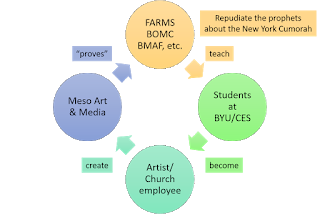 |
| The academic cycle that must be disrupted to stop M2C |
In May I posted comments about how certain intellectuals continue to promote M2C because of sunk costs; i.e., they’ve invested so much time, effort and money into M2C that they feel compelled to stick with it, even to the point of repudiating the prophets they otherwise revere.
https://bookofmormonconsensus.blogspot.com/2018/05/sunk-costs-and-m2c.html
This is another manifestation of the academic cycle; i.e., M2C is perpetuated by persuading new students to invest in M2C so they, too, succumb to the sunk cost fallacy.
The sunk cost rationale is irrational, of course.
One explanation puts it this way:
The Truth: Your decisions are tainted by the emotional investments you accumulate, and the more you invest in something the harder it becomes to abandon it.
_____
In the context of M2C, the sunk cost fallacy arises when we have BYU/CES teachers and COB employees who have long taught and promoted M2C. They are responsible for imprinting M2C on the minds of thousands of faithful Latter-day Saints–as well as thousands who have lost their faith in the Book of Mormon because of the two-Cumorahs theory, as Joseph Fielding Smith warned.
These teachers and employees have made tremendous emotional investments in M2C. Every year, these teachers at BYU/CES are making even greater emotional investments as they teach their students that the prophets are wrong about the New York Cumorah.
We recognize that such investments would make it very difficult for the BYU/CES teachers to change their mind, but one would think they would nevertheless value the teachings of the prophets over their own M2C ideology.
Now there’s a study that shows how other species, including mice, are affected by sunk costs. This suggests that the sunk cost fallacy has such a deep impact on the BYU/CES/COB employees that they actually cannot adjust their thinking.
They have sunk so many costs into M2C that they literally cannot change their minds.
Here is the abstract of the article. Look how well it explains M2C:
Abstract
Sunk costs are irrecoverable investments that should not influence decisions, because decisions should be made on the basis of expected future consequences. Both human and nonhuman animals can show sensitivity to sunk costs, but reports from across species are inconsistent. In a temporal context, a sensitivity to sunk costs arises when an individual resists ending an activity, even if it seems unproductive, because of the time already invested. In two parallel foraging tasks that we designed, we found that mice, rats, and humans show similar sensitivities to sunk costs in their decision-making. Unexpectedly, sensitivity to time invested accrued only after an initial decision had been made. These findings suggest that sensitivity to temporal sunk costs lies in a vulnerability distinct from deliberation processes and that this distinction is present across species.
https://medicalxpress.com/news/2018-07-mice-rats-humans-poor-choices.html
The “initial decision” in this case is the M2C dogma that the Book of Mormon took place in Mesoamerica, that there are “two Cumorahs,” and that the prophets are wrong about the New York Cumorah being the Cumorah of Mormon 6:6.
Having made their decision, the M2C intellectuals have a sunk cost that influences future decisions, including the decision whether or not to repudiate the prophets.
Another way to look at this is that M2C is not the product of a deliberation process. It’s a product of an initial decision, usually based on what a trusted teacher claimed, followed by investment of time, energy and reputation.
These sunk costs prevent M2C intellectuals from changing their minds in response to the teachings of the prophets and the abundant evidence in North America that corroborates what the prophets have taught, beginning with Letter VII.
_____
While we understand how powerful the sunk cost fallacy is, and we empathize with the M2C intellectuals who are trapped by this thinking, we are not bound by compassion to simply accept their teachings. The sunk cost fallacy makes it all the more important for us to break the academic cycle that perpetuates M2C so that future generations do not succumb to the sunk cost fallacy.
Source: Book of Mormon Concensus
